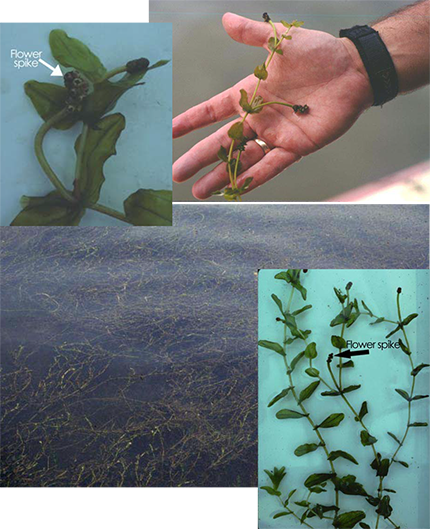Submerged Aquatic Vegetation (SAV) Identification Key
Main_Content
The bay grass key was designed to allow you to identify most species of bay grasses found in Maryland. Although bay grasses are notoriously difficult to identify using standard taxonomic keys, the flexible format of the Internet allows us to combine detailed pictures, simple line drawings and text messages in a stepwise sequence that makes identifying bay grasses simple. You may find it useful to have a clear metric ruler with millimeters marked, a magnifying glass, and a Ziploc plastic bag to help you in the process of identifying your plant.

|
If you already know the identity of a particular bay grass use the drop down boxes below. |
|---|
Common Name:
or
Scientific Name:
| | Common Name: | Redhead Grass |
| | Scientific Name: | Potamogeton perfoliatus |
| | Native or Non-native: | Native
|
| | Illustration: | 
|
| | Link to larger illustration: | |
| | Printable Version: | |
| | Family: | Potamogetonaceae |
| | Distribution: | Redhead grass is typically found in fresh to moderately brackish and alkaline waters. Redhead grass grows best on firm, muddy soils and in quiet water with slow-moving currents. The wide, horizontal leaves of redhead grass may be more susceptible to covering by epiphytic growth than those of other bay grasses.
|
| | Recognition: | Redhead grass is highly variable in its appearance and, in fact, two stems on a single plant may appear to be separate species. In relatively shallow water, for example, plants have thicker, darker green foliage than do plants growing in deeper water. Leaves of redhead grass are flat and oval-shaped, 1-7 cm (< 1/3 in to 2 ¼ in) long and 1-4 cm (1/3 in to 1 2/3 in) wide with parallel venation. Leaf margins are slightly crisped, and basal parts of leaves clasp straight and slender plant stems. Leaf arrangement is alternate to slightly opposite. Branching is more developed in the upper portion of the plant. Redhead grass has an extensive root and rhizome system that securely anchors the plant. |
| | Ecological Significance: | Redhead grass probably got its common name from the redhead ducks often found feeding on it. Redhead grass is considered an excellent food source for waterfowl. It is also one of the most easily recognizable bay grass species in the bay because of its flat, oval-shaped leaves, the base of which are attached to the plant stem. |
| | Similar Species: | Young shoots of redhead grass may be confused with curly pondweed (Potamogeton crispus). |
| | Reproduction: |
Asexual reproduction occurs by formation of over-wintering, resting buds at the ends of rhizomes. Sexual reproduction regularly occurs in early to mid-summer. Spikes of tiny flowers emerge from leaf axils on ends of plant stems. Flower spikes extend above the water surface and the pollen is wind-carried. As fruits mature they sink below the surface where they release seeds. Attempts to propagate plants from seed have been unsuccessful. |
|
|
Center_Content
For permission to reproduce individual photos, please contact Mike Naylor
The text and photos used in this key were produced through a collaborative effort among the following partners.

